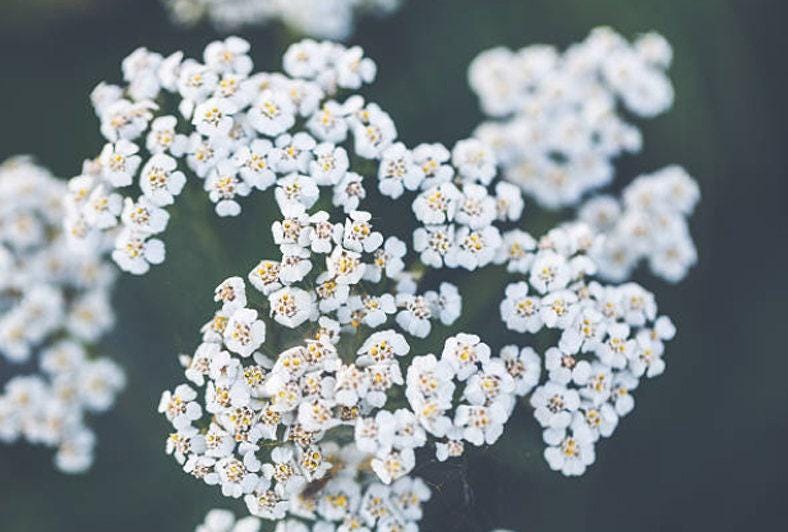This is an important native North American wildflower and pollinator plant. Its feathery foliage is a major source of food for bighorn sheep, pronghorn antelope, deer, and wild fowl. In the early days of the American prairies, Native American tribes such as the Pawnee, Cherokee, and Chippewa used common yarrow. Attracts beneficial insects. Great cut flower.
This variety grows 10-36" (25-90cm) tall, with densely hairy, lacy, fern-like leaves. It has an extended bloom period from May to September, and is very attractive to beneficial insects, including predatory wasps, ladybird beetles, and hover-flies that prey on aphids and garden grubs. The scent of yarrow repels aphids. Western Yarrow is also highly drought-resistant, so it's excellent for xeriscaping and erosion control. It thrives particularly in recently disturbed soil. Because of this feature, Western Yarrow seeds are often used in reclamation and restoration projects in dryland areas. especially useful for planting around work sites, septic berms, or roadside areas. Yarrow makes an excellent pollen source in arid conditions.
The leaves and stems of yarrow contain enzymes that break down rapidly, so it can be added to the compost raw or as a tea to accelerate the heap.
Latin Name: Achillea millefolium occidentalis
Species Origin: US Native Wildflower
Type: Native Wildflowers
Life Cycle: Perennial
USDA Zones: 1, 2, 3, 4, 5, 6, 7, 8, 9, 10, 11, 12
US Regions: California, Mountain, Arid/Desert, Plains/Texas, Midwest, Northern, Northeast, Southeast
Stratification: No Stratification
Sunlight: Full Sun
Height: 24 Inches
Color: White
Bloom Season: Blooms Early Summer, Blooms Late Summer
Uses: Attracts Pollinators, Attracts Honeybees, Attracts Butterflies, Aromatic, Cut Flowers, Dried Flowers, Deer Resistant
~ sowing ~
Indoors:
Sow indoors 8-10 weeks before planting out after the last frost date. Transplant or direct sow in early spring or early autumn. Optimal soil temperature for germination: 15-18°C (60-65°F). Seeds can take 10 to as long as 100 days to sprout, so be patient. Bottom heat speeds germination.
Sow on the surface of the soil, under bright lights if starting indoors - since they need light to germinate.. Transplants can go out while the soil is still cool and there is still some risk of light frost. Space transplants at 30-60cm (12-24″) apart.
Outdoors:
Direct sow western yarrow seeds in fall or early spring; fall planted seed will remain dormant until spring.
Seed Depth: Press into surface
Seed Spacing: A group of 3 seeds every 18"–24"
Thinning: When 2" tall, thin to 1 every 18"–24"
~ growing ~
Yarrow is a tough plant that is suitable for xeriscaping, and it will adapt to pretty much any soil. For best results, grow in a loamy, well drained soil with a pH of 5.5 to 7.0. Divide plants every 3-4 years. Cut plants to ground level in autumn.
While the young plants should be watered to help them establish a deep root system, too much watering of mature plants can cause stem and root rot or mildew. This species grows best in sandy or well drained soil, and tolerates drought conditions. Since yarrow tends to flop over in fertile soil or shade, staking may be needed; this also protects the plant's fragile stems in high winds. Deadhead the wilted blossoms often for continued blooming. After the plant has finished blooming, cut the plant down to its lower leaves for healthy spring growth.
When the plant becomes 3-4 years old, it will benefit from being dug up and divided in the early spring or fall. Because yarrow can become invasive through the spread of roots and its reseeding habit, care should be taken to control the spread of the plant. This can be done by putting a barrier underground surrounding the plant's roots, or by growing the plant in large container.
~ harvesting ~
Gather leaves and flowers as soon as they mature. Harvest the whole stem as soon as it begins to bloom; bundle the stems and hang them upside down to dry away from direct sunlight. Yarrow blossoms make good cut flowers, and when dried they hold their color well. Keep in mind that if the flowers have been open for more than a day, they will go to seed as they dry. Individual blossoms or leaves can also be harvested and spread out to dry in a protected location.
~ seed saving ~
Allow the flower heads to mature and begin to dry; the stem will start to turn brown. Remove the heads and spread them out to dry out of direct sunlight, then rub them lightly to release seeds. Store western yarrow seeds in a cool, dark place.
All Nimble NiteCap Seeds are:
• Heirloom
• Organic
• Non-GMO
• Open Pollinated
• Untreated
• US Grown
• growing instructions included
• Regular testing is conducted to uphold the highest germination standards, all the while employing appropriate seed storage techniques.
Sustainable Packaging & Shipping:
• NimbleNitecap seeds are packed in eco-friendly, compostable seed packets. Seed packets are printed in house with vegetable-based inks on biodegradable, recycled materials. (Small plastic bags are infrequently used to prevent the loss of very small seeds.)
• All orders are carefully packed and shipped with tracking via USPS First Class (or Priority, if selected) in padded ECOENCLOSE recycled and reusable mailers, or recycled boxes to protect your items in transit.
Most orders ship out the same or next business day! Please note that this time may be extended during peak season.
• FREE SHIPPING on all orders of $35 or more. Flat Rate shipping no matter how many packets you order.



















